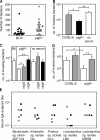Innate secretory antibodies protect against natural Salmonella typhimurium infection
- PMID: 16390940
- PMCID: PMC2118088
- DOI: 10.1084/jem.20052093
Innate secretory antibodies protect against natural Salmonella typhimurium infection
Abstract
The production of IgA is induced in an antigen-unspecific manner by commensal flora. These secretory antibodies (SAbs) may bind multiple antigens and are thought to eliminate commensal bacteria and self-antigens to avoid systemic recognition. In this study, we addressed the role of "innate" SAbs, i.e., those that are continuously produced in normal individuals, in protection against infection of the gastrointestinal tract. We used polymeric immunoglobulin receptor (pIgR-/-) knock-out mice, which are unable to bind and actively transport dimeric IgA and pentameric IgM to the mucosae, and examined the role of innate SAbs in protection against the invasive pathogen Salmonella typhimurium. In vitro experiments suggested that innate IgA in pIgR-/- serum bound S. typhimurium in a cross-reactive manner which inhibited epithelial cell invasion. Using a "natural" infection model, we demonstrated that pIgR-/- mice are profoundly sensitive to infection with S. typhimurium via the fecal-oral route and, moreover, shed more bacteria that readily infected other animals. These results imply an important evolutionary role for innate SAbs in protecting both the individual and the herd against infections, and suggest that the major role of SAbs may be to prevent the spread of microbial pathogens throughout the population, rather than protection of local mucosal surfaces.
Figures



Similar articles
-
Vaccine-induced protection against gastrointestinal bacterial infections in the absence of secretory antibodies.Eur J Immunol. 2005 Jan;35(1):180-8. doi: 10.1002/eji.200425492. Eur J Immunol. 2005. PMID: 15593123
-
Entry route of Salmonella typhimurium directs the type of induced immune response.Immunity. 2007 Dec;27(6):975-84. doi: 10.1016/j.immuni.2007.10.011. Immunity. 2007. PMID: 18083577
-
Lactoferrin increases both resistance to Salmonella typhimurium infection and the production of antibodies in mice.Immunol Lett. 2010 Nov 30;134(1):35-46. doi: 10.1016/j.imlet.2010.08.007. Epub 2010 Aug 18. Immunol Lett. 2010. PMID: 20727369
-
The polymeric immunoglobulin receptor: bridging innate and adaptive immune responses at mucosal surfaces.Immunol Rev. 2005 Aug;206:83-99. doi: 10.1111/j.0105-2896.2005.00278.x. Immunol Rev. 2005. PMID: 16048543 Review.
-
Induction of secretory immunity and memory at mucosal surfaces.Vaccine. 2007 Jul 26;25(30):5467-84. doi: 10.1016/j.vaccine.2006.12.001. Epub 2006 Dec 15. Vaccine. 2007. PMID: 17227687 Review.
Cited by
-
New concepts in the generation and functions of IgA.Nat Rev Immunol. 2012 Dec;12(12):821-32. doi: 10.1038/nri3322. Epub 2012 Oct 29. Nat Rev Immunol. 2012. PMID: 23103985 Review.
-
Lactoferrin Adsorbed onto Biomimetic Hydroxyapatite Nanocrystals Controlling - In Vivo - the Helicobacter pylori Infection.PLoS One. 2016 Jul 6;11(7):e0158646. doi: 10.1371/journal.pone.0158646. eCollection 2016. PLoS One. 2016. PMID: 27384186 Free PMC article.
-
Vaccine-induced inflammation and inflammatory monocytes promote CD4+ T cell-dependent immunity against murine salmonellosis.PLoS Pathog. 2023 Sep 21;19(9):e1011666. doi: 10.1371/journal.ppat.1011666. eCollection 2023 Sep. PLoS Pathog. 2023. PMID: 37733817 Free PMC article.
-
Independent bottlenecks characterize colonization of systemic compartments and gut lymphoid tissue by salmonella.PLoS Pathog. 2014 Jul 31;10(7):e1004270. doi: 10.1371/journal.ppat.1004270. eCollection 2014 Jul. PLoS Pathog. 2014. PMID: 25079958 Free PMC article.
-
IgA and FcαRI: Versatile Players in Homeostasis, Infection, and Autoimmunity.Immunotargets Ther. 2021 Jan 5;9:351-372. doi: 10.2147/ITT.S266242. eCollection 2020. Immunotargets Ther. 2021. PMID: 33447585 Free PMC article. Review.
References
-
- Brandtzaeg, P., E.S. Baekkevold, I.N. Farstad, F.L. Jahnsen, F.E. Johansen, E.M. Nilsen, and T. Yamanaka. 1999. Regional specialization in the mucosal immune system: what happens in the microcompartments? Immunol. Today. 20:141–151. - PubMed
-
- Ogra, P.L., J. Mestecky, M.E. Lamm, W. Strober, J.R. McGhee, and J. Bienenstock. 1999. Mucosal immunoglobulins. Handbook of Mucosal Immunology. Academic Press, San Diego, CA. 133–135.
-
- Brandtzaeg, P., and H. Prydz. 1984. Direct evidence for an integrated function of J chain and SC in epithelial transport of Ig. Nature. 311:71–73. - PubMed
Publication types
MeSH terms
Substances
LinkOut - more resources
Full Text Sources
Other Literature Sources
Molecular Biology Databases
Miscellaneous

